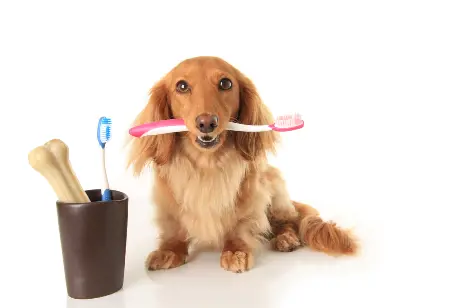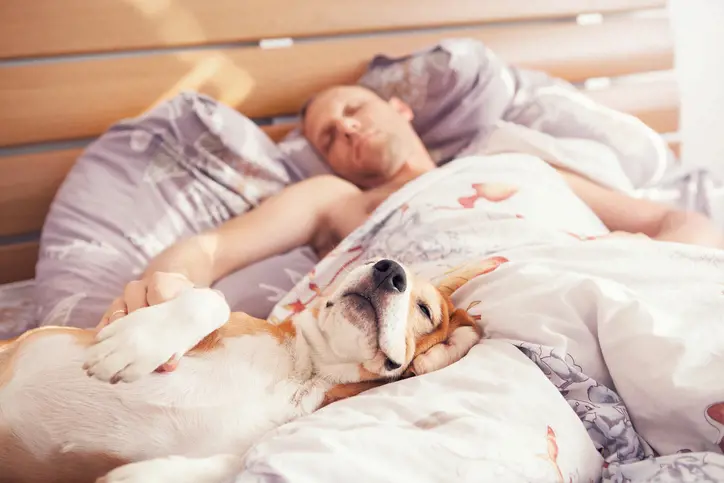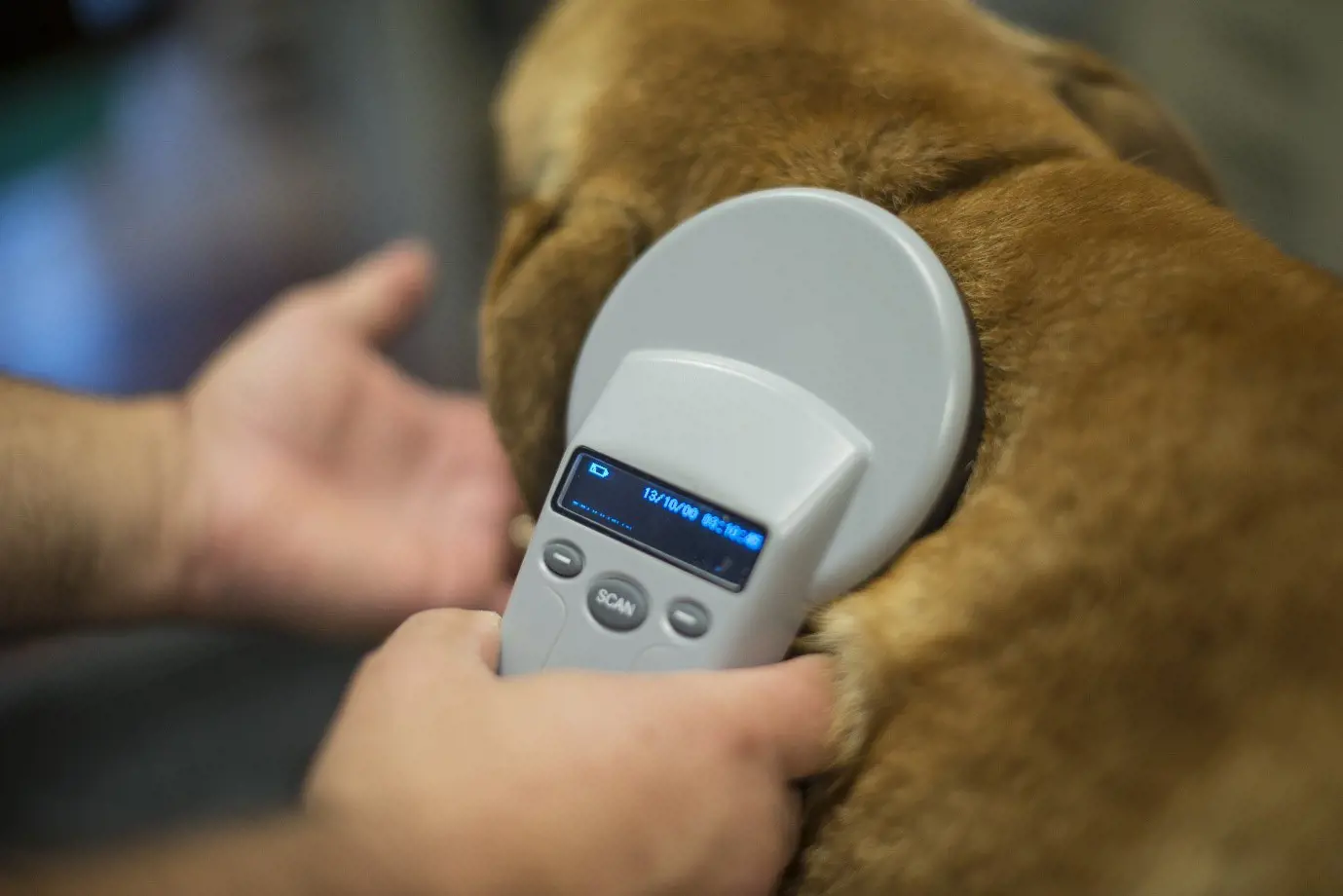Dental issues in dogs: A guide to keeping your pet’s teeth gleaming!
24th January, 2024

We’ve teamed up with our trusted vet care provider Joii, to embark on a toothsome adventure. Join us as we delve into the secrets of pet dental health, exploring tips, tricks, and expert advice to keep your furry friends’ smiles shining bright!
Just like humans, many cats and dogs have problems with their teeth. In fact, it’s estimated that more than 80% of UK dogs and cats over 4 years old have some degree of dental disease!
Things to think about
- Untreated dental disease can lead to serious health problems, including chest infections, kidney disease, and heart damage.
- Regular tooth brushing, starting from a young age, can help prevent dental disease in dogs.
How can I tell if my pet has dental disease?
Well, the chances are, you’ll be the first to know! Dental disease is the number one cause of bad breath in cats and dogs. So, when that cosy cuddle with your fur baby becomes a breath-holding endurance test, it’s time to act!
In fact, its way past time to act, because the good news is that most dental problems can be prevented. The challenge is making a commitment to our 4-legged friends to look after their teeth in the same way we need to look after our own!
Other warning signs of dental disease include
- Dropping food or eating on one side of their mouth
- Eating soft food and leaving the kibble
- Dribbling saliva
- Rubbing/pawing at their mouth
- Losing weight
Caution: What happens if dental issues are left untreated?
Our 4-legged friends won’t complain about toothache the way we do, they just get on with life. This is particularly true of cats, but many pet parents see a dramatic change in the personality of their pets after the relief of dental surgery.
It’s stark proof of how much a sore mouth can drag pets down, especially older pets. And untreated dental disease can lead to, or worsen, some life-threatening illnesses, including:
- Chest infections and bronchopneumonia
- Septicaemia (bacteria multiplying in the bloodstream)
- Kidney disease
- Heart damage (bacterial endocarditis)
Dental disasters
Tooth decay
Tooth decay happens when bacteria in the mouth grow on the surface of the teeth to form a layer of plaque. Plaque is hard to remove from teeth.
Dental scale (calculus) is the hard brown stuff that forms when plaque hardens on the tooth, acid is produced by the oral bacteria, and plaque attacks the teeth, causing tooth decay. And that means teeth getting loose and falling out.
The first warning sign of dental disease. Is gingivitis - red inflamed gums.
What causes tooth decay?
Poor diet: Sugary human food and poor-quality pet food are huge problems.
An overcrowded mouth: Believe it or not, all dogs have the same number of teeth, no matter how short their face is. So, a pug or French bulldog has the same number of teeth as a German Shepherd but packed in very tightly and overlapping. The result?
- Early damage to emerging teeth in puppies
- Trapped decaying food
- Poor contact with saliva and tongue (both of which usually combat plaque)
- Weakened ‘anchoring’ of teeth in the mouth
FORLS (feline odontoclastic resorptive lesions)
Cats are prone to a nasty form of dental disease where the root of the tooth is eaten away beneath the gum. This is called FORLS, the first visible evidence may be missing teeth- as the top part of the tooth (the crown) is weakened and lost, it is very, very painful.
Broken teeth
Pets may snap their teeth biting down on hard objects like stones, bones, or kennel bars. The four big fang teeth (canines) are the usual victims. If the live part of the tooth (the pulp) is exposed, the infection gets inside the tooth. The vet will likely advise removing or filling what’s left of the tooth.
Loose teeth
Loose teeth can be a result of tooth decay and gum disease. Poor diet, overcrowded mouth, and broken teeth can also contribute to loose teeth in dogs.
Bad breath
Bad breath can be a sign of dental problems and general poor health. Dogs generally don't have the nicest of smelling breaths anyway! However, if you notice something particularly 'off' about your dog's breath, it may be worth looking into this in a bit more detail.
Tackling bad breath might make other issues your dog might be having become a bit more obvious, so it can be a good idea to get your toothbrush at-the-ready and start brushing regardless of if there's an underlying issue or not!
Gingivitis
Gingivitis is a common form of dental disease in dogs and refers to inflammation of the gums. It's often caused by a build-up of plaque and tartar on the teeth, which can lead to bacterial infection and irritation of the gums.
If left untreated, gingivitis can progress to periodontitis, a more severe form of gum disease that can result in tooth loss and damage to the supporting structures of the teeth.
Excessive drooling
Excessive drooling in dogs can indicate the presence of gum disease or oral infections.
Signs of excessive drooling in dogs
- Constantly dripping saliva from the mouth
- Wetness around the mouth and chin area
Causes of excessive drooling in dogs
- Gum disease: Poor oral hygiene can lead to the development of gum disease, which can cause excessive drooling.
- Oral infections: Infections in the mouth, such as abscesses or periodontal disease, can also cause dogs to drool excessively.
Bleeding gums
This condition can be the first 'tell-tale' sign of bigger teeth problems.
Causes of gum bleeding in dogs
- Poor oral hygiene: Lack of regular teeth brushing, and dental care can lead to plaque build-up and gum inflammation, resulting in bleeding of the gums.
- Gum disease: Periodontal disease is a common cause of a bleeding gum in dogs. It's a bacterial infection that affects the gums and supporting structures of the teeth.
Signs to be aware of
- Blood on toys or chew bones
- Bad breath
- Redness and swelling of the gums
- Problems eating or chewing
- Reluctance to have their mouth touched
Discoloured teeth
Why are my dog's teeth discoloured?
Discoloured teeth in dogs can be caused by a variety of factors. One common cause is plaque build-up, which can lead to tartar formation and yellowing of the teeth. Other possible causes include decay, poor oral hygiene, and certain medications or illnesses.
Pawing at the mouth
As a dog owner, it can be concerning to see your furry friend pawing at their mouth, which is often a sign of dental problems that need attention. When dogs paw at their mouth, it could indicate issues with their teeth or gums.
Here are some important points to consider:
- Common dental problems that may cause pawing at the mouth include tooth fractures or damage to the gums.
- Tooth fractures can occur when dogs chew on hard objects, such as bones or rocks.
- Damage to the gum line can lead to pain and discomfort, causing dogs to paw at their mouth in an attempt to alleviate it.
Visible tartar
When dogs paw at their mouth, it could indicate issues with their teeth or gums, such as visible tartar. Visible tartar is a common dental problem in dogs that occurs when plaque hardens on the tooth surface. This can lead to decay and gingivitis, causing red and inflamed gums.
Abnormal discharge from the mouth
When you see abnormal discharge from your dog's mouth, it's important to take it seriously and address the issue promptly.
Causes of abnormal discharge from the mouth
- Gum disease: This can cause inflammation and infection, leading to discharge.
- Tooth infection: An infected tooth can result in pus or discharge.
Signs to look out for
- Excessive drooling or saliva production
- Foul odour coming from the mouth
What to do if you notice abnormal discharge
- Schedule a dental check-up with your veterinarian.
- Follow their recommended treatment plan, which may include dental cleaning, tooth extraction, or antibiotics.
Chewing on one side
When abnormal discharge is present, it is not uncommon for dogs to favour chewing on one side of their mouth. This could be a sign of dental disease in dogs, which can cause discomfort and pain.
Oral infection
Oral infections can occur when bacteria build up in the mouth, causing inflammation and damage to the gums and teeth. Here are some important points to know about oral infections in dogs:
- Symptoms of oral infection include bad breath, swollen or bleeding gums, difficulty eating, and tooth loss.
- Oral infections can progress to more severe conditions, such as tooth root abscesses, which can be extremely painful for dogs.
- Regular dental check-ups and professional cleanings are crucial for preventing and treating oral infections.
- Good oral hygiene practices, such as regular brushing and providing dental chews, can also help maintain a healthy mouth.
- In severe cases, dental surgery may be necessary to remove infected teeth and treat the underlying infection.
Reduced appetite
A common symptom of dental problems in dogs is a reduction in appetite. When dogs experience dental disease, they may have difficulty chewing and swallowing their food, leading to a decreased desire to eat. This can be concerning for pet owners who want to ensure their furry friends are getting the necessary nutrition.
- Dental disease can cause pain and discomfort while eating, leading to a loss of appetite.
- Dogs may exhibit signs of dental problems such as dropping food or eating on one side of their mouth, eating soft food and leaving the kibble, dribbling saliva, and rubbing or pawing at their mouth.
- Untreated dental disease can result in serious health issues, including chest infections, septicaemia, kidney disease, and heart damage.
- Regular dental check-ups, proper dental hygiene practices like brushing their teeth, and feeding them a balanced diet can help prevent dental disease and maintain their appetite.
Weight loss
Dental problems, such as tooth decay and periodontal disease, can have a significant impact on a dog's overall health and weight.
When dogs experience pain or discomfort in their mouths, they may have trouble eating or may avoid certain types of food altogether. This can lead to weight loss and nutritional deficiencies.
Additionally, dental problems can affect a dog's ability to properly chew and digest their food, further contributing to weight loss. Therefore, dog owners may want to address dental problems promptly to ensure their pet maintains a healthy weight and receives the necessary nutrients for optimal well-being.
Deciduous teeth
Deciduous teeth, also known as retained baby teeth, are the first set of teeth that puppies have. These teeth eventually fall out to make way for the permanent teeth.
However, problems can occur during this process, leading to dental issues in dogs. One common problem is retained deciduous teeth, where the baby teeth do not fall out properly and cause overcrowding.
This can lead to misalignment of the permanent teeth and difficulty in chewing. Another issue is delayed tooth loss, where the baby teeth persist for too long, preventing the eruption of the permanent teeth.
This can result in dental abnormalities and potential tooth loss. It's important to monitor your dog's dental development and consult with a Joii vet if you notice any issues with their baby or adult teeth.
As a Purely Pets customer, enjoy the perk of access to dental health clinics with expert nurses on the Joii app, all included as a part of your policy!
Tooth resorption
Tooth resorption is a condition where the structure of a tooth is broken down and absorbed by the body. This can lead to tooth loss and oral pain for dogs.
Factors such as dental disease, trauma, and inflammation may contribute to its development. If left untreated, tooth resorption can lead to discomfort, finding it tough to eat, and further dental complications.
To diagnose tooth resorption, a veterinarian will perform a dental examination and may recommend dental x-rays. Treatment options for tooth resorption include extraction of the affected teeth and pain management.
Regular dental check-ups and proper oral hygiene can help prevent tooth resorption and other dental issues in dogs.
Dental disease may complicate diabetes in dogs
When a dog has both dental disease and diabetes, it may create a challenging situation that requires careful management when it comes to diabetes (if your dog has diabetes that is).
If your dog does have diabetes, here are some important points to consider
- Inflammation and infection in the mouth can cause stress on the body, leading to increased blood sugar levels in diabetic dogs.
- Poor blood sugar control can worsen dental disease, creating a vicious cycle.
Increased risk of complications
- Dental disease can lead to gum infections, which can spread to other parts of the body and worsen diabetic symptoms.
- Dogs with diabetes are more prone to developing periodontal disease, which can further impact their health.
Irritability
Irritability can be a common symptom of dental problems in dogs. When dogs are experiencing dental issues, such as decaying teeth or gum disease, they may become irritable and exhibit changes in behaviour. This can include increased aggression, restlessness, or a reluctance to be touched or handled.
Jaw fractures
Dealing with jaw fractures can be a challenging aspect of dental problems in dogs. When a dog suffers from a jaw fracture, it can cause severe pain and difficulty in eating and drinking.
- Immediate veterinary attention is crucial to assess the extent of the fracture and determine the appropriate treatment.
- X-rays may be required to accurately diagnose and evaluate the fracture.
- Treatment options may include pain management, immobilisation of the jaw with a splint or wiring, or in severe cases, surgical repair.
- Fractured teeth may also be present and will require treatment such as extraction or root canal therapy.
- Careful monitoring and follow-up visits with the veterinarian are necessary to ensure proper healing and prevent complications.
What is Periodontal disease?
Periodontal disease is a common dental problem in dogs. It refers to inflammation and infection of the tissues surrounding the teeth, including the gums and the bone that supports the teeth. This condition is caused by the build-up of plaque, a sticky film of bacteria that forms on the teeth.
If left untreated, periodontal disease can lead to tooth loss and other serious health issues in dogs. The signs of periodontal disease include bad breath, swollen or bleeding gums, difficulty eating, and loose teeth.
Regular dental care, including brushing your dog's teeth and regular dental check-ups, can help prevent and manage periodontal disease. It's essential to prioritise your dog's dental health to ensure their overall well-being.
Do dogs lick when their teeth hurt?
When dogs experience dental pain, they may exhibit an increase in licking behaviour. This is their way of trying to alleviate the discomfort in their mouths. Dog owners need to be aware of this behaviour and understand its significance.
Here are some key points to look out for
- Excessive licking of their lips, gums, or the roof of their mouth.
- Persistent licking of objects or surfaces.
- Increased saliva production.
- Reasons why dogs may lick when their teeth hurt:
- Licking can provide temporary relief by stimulating saliva production, which can help soothe the painful areas in the mouth.
- Dogs may also lick as a way to clean their teeth or remove any food particles that are causing discomfort.
It's important to note that while licking may provide temporary relief, it isn't a solution to dental issues. If your dog is exhibiting signs of dental pain, it may be worth consulting with your Joii vet expert. They can provide a proper examination and recommend appropriate treatment options, such as tooth extraction, if necessary.
How can I protect my pet from dental disease?
Brush their teeth- When you get a puppy or kitten, start brushing their teeth from the get-go. Start gradually and make it part of a routine. Ask your vet for advice at that first puppy or kitten check.
Ideally, start early and make it a lifelong commitment. But it’s never too late to start caring for your pet’s teeth. After all, they can’t do it for themselves.
What you’ll need:
- Pet toothpaste. There are some specifically designed toothpaste to help break down plaque. And they come in a variety of pet-friendly flavours
- A toothbrush, finger brush or even a microfibre cloth
- Pet parent patience and perseverance, and a bit of cooperation from your fur baby certainly helps!
Aim to clean both sides of all the teeth, including the back ones. Be sure to get the base of the tooth, where it meets the gum. That’s where bacteria and plaque are active.
A microfibre cloth instead of a brush can work well and is often better tolerated by pets. While toothpaste helps, it's not essential, so costs of dental care can be minimal.
Dearly as we love them though, not all of our fur babies understand the word ‘cooperation.’ So, if keeping your existing fingers has to be a priority, we’ll need to look at other options to help reduce dental disease.
Dental chews
Choose ones that are suitable for your pet’s age and size to prevent choking hazards or things stuck in their tummies. Many edible chews are rather high in calories and fat, so may not be suitable if your pet suffers from an illness like pancreatitis or obesity.
Dental health diets
At its simplest, this means feeding your pet a good quality complete pet food. And giving healthy snacks like safe fruit or veg or their own kibble as snacks. No sugary cakes, ice cream, biscuits, toast, marmalade, or any of the other sugary treats that also wreck our own teeth and waistlines.
Prescription diets
Very effective in helping to address dental disease in cats and dogs.
Talk to your vet about whether these special diets would help your pet.
Regular dental check ups
Most vets offer regular dental checks for pets to help pet parents monitor and care for their fur family’s teeth. This is particularly important for ‘harder to spot’ conditions like FORLS in cats or common dental disease and cavities in Labradors. At some point, your vet may advise ‘a dental’ or dental surgery.
Dental surgery
Your pet will have a general anaesthetic so they’re asleep to have dental work. It's the only way to do this safely and effectively. They may also need x-rays to check the roots of teeth below the gums. Particularly for cats with FORLS.
Procedures
- Removing loose or decayed teeth.
- A scale and polish- removing the build-up of plaque and scale with a handheld ultrasonic cleaner.
- Filling or crowning teeth - There are specialist veterinary dentists who carry this out on referral from your vet.
How much does it cost to protect my pet’s teeth?
- A new toothbrush and toothpaste - about £24 per year.
- Dental diets: For example, Hill's Prescription Diet t/d dental care - £1 per day for a 10kg dog, £0.75 per day for a 4kg cat.
- Scale and polish (cleaning the teeth under anaesthetic) - averages around £325 if there are no extractions or complications.
And the cost of not protecting my pet...?
- Major dental surgery - extractions, surgical extractions, gum surgery - which can cost many hundreds of pounds or more.
- The cost of treating illnesses related to dental disease, this could potentially reach into hundreds of pounds or more.
- Your cat or dog living with the constant pain of a diseased and inflamed mouth.
It’s an uneven balance!
And remember. It’s never too late to start with dental care. So, for their sake, and to ensure cuddles with our four-legged friends aren’t spoiled by smelly breath, let’s look after their teeth!
Our Joii vets are available 24 hours a day, 365 days a year. If you have any questions about what to feed your pet, how to assess their weight, or if you are worried that they have eaten something they shouldn’t have - download the app and speak to a professional straight away.



Helpful Pages
Recent Posts
Pet Insurance Quote
- 98% claims paid *
- Claims paid directly to vets
- 24/7 vet video consultations
- Interest free monthly payments




